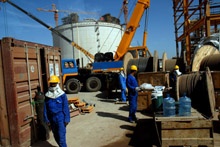
Typical street scene in Santa Ana, El Salvador. (Photo: iStock)
IMF Survey: New IMF Loan Backs Yemen's Reform Efforts
August 3, 2010
- Yemen’s declining oil revenues make fiscal restructuring key
- Social safety net to be strengthened
- Donor support will be critical to the program’s success
The IMF’s Executive Board has approved a $369.8 million loan for Yemen to support the Middle Eastern nation’s plan to restructure its public finances, protect the poor, and boost growth.

A liquefied natural gas plant on the south coast of Yemen: The country is looking for new sources of revenue as its oil supply dwindles (photo: AFP/Khaled Fazaa)
MIDDLE EAST
The three-year arrangement under the Extended Credit Facility marks the first time in nearly a decade that Yemen has requested IMF financial assistance.
Yemen, one of the poorest countries in the Middle East, is confronted with a range of difficult economic issues. The country has one of the highest malnutrition rates in the world, and an estimated 43 percent of its 23 million citizens live below the national poverty line. Yemen’s oil reserves, on which the economy depends heavily, are expected to run out within a decade in the absence of new oil discoveries. The country is also facing depletion of its groundwater. These challenges are compounded by a rapidly growing population, poor infrastructure, weak institutional capacity, a difficult security situation, and civil unrest.
The past few years have been exceptionally difficult for the Yemeni economy, the IMF says in its latest assessment of the country. Oil production dropped substantially beginning in 2007. With the collapse of international oil prices in late 2008, the country’s oil revenues—which account for about 60 percent of government revenues and over 90 percent of export revenues—have declined. Although Yemen began producing liquefied natural gas in late 2009, this positive development only partially offset the impact of the fall in oil revenues.
Because of the hydrocarbon sector’s dominance of the economy, the loss of oil revenue had a strongly negative impact on public finances and the balance of payments, contributing to a record fiscal deficit of about 10 percent of GDP and putting the balance of payments under considerable strain.
These adverse developments put pressures on the exchange rate, the IMF report notes, leading to a loss of foreign exchange reserves. The Yemeni rial depreciated by 3 percent against the U.S. dollar in 2009 and by a further 9 percent in the first half of 2010, while foreign exchange reserves dropped by one-third in the same period.
Putting public finances on a sustainable path
In response to the deteriorating economic situation, the government has outlined a program of reforms to address the prospect of lower oil revenues while boosting public investment and social spending. The program is part of the authorities’ broader medium-term strategy, which focuses on accelerating growth outside the hydrocarbon sector while maintaining inflation within moderate levels and on putting public finances on a more solid medium-term footing.
Specifically, the program aims to reduce the overall deficit to about 3½ percent of GDP by 2013 (from about 10 percent in 2009) through a number of measures.
First, the authorities plan to cut fuel subsidies which, at about 8-10 percent of GDP, are the largest in the region. To counteract the resulting rise in fuel prices, the authorities are increasing social transfers to protect the most vulnerable segments of the population.
Second, the government plans a series of tax policy and administration reforms to reduce the country’s reliance on the hydrocarbon sector. Later this year, the Yemeni authorities intend to put in place a package of tax policy reforms that would eliminate most income tax and customs exemptions. Other critical fiscal reforms have already begun. On July 1, the authorities fully implemented a General Sales Tax (GST)—a measure that had been in the works for about a decade but had never been fully executed, owing to opposition by the business community and other problems. The full adoption of the GST sends a powerful signal of the government’s commitment to addressing emerging imbalances.
Third, the authorities will strive to contain nonessential current expenditures, shifting the balance away from current spending toward capital spending and social transfers. This shift—from 70 percent and 30 percent, respectively, to approximately 65 percent and 35 percent—is intended to strengthen the social safety net and bring about the sustained levels of public investment needed to achieve the country’s growth objectives.
Over the medium term, further progress in improving the business climate will also be essential, the IMF report notes.
Role of donor support
Support from the international donor community will be vital to the program’s success. At a 2006 donor conference in London, Yemen’s development partners pledged about $4.7 billion, but only a portion of the promised funds have been disbursed.
More recently, the donor community has revived its activities through the “Friends of Yemen,” an international group formed to drive economic and political reform in the country. The process started with a high-level meeting in London in January 2010 that recognized the magnitude of the challenges that Yemen is facing and the need to react quickly. Members of the group have called on the government to enact economic reforms of the sort outlined in the new IMF-supported program.
It would be difficult for Yemen to make tangible progress toward meeting the Millennium Development Goals in the absence of significant donor aid, the IMF assessment emphasizes.







